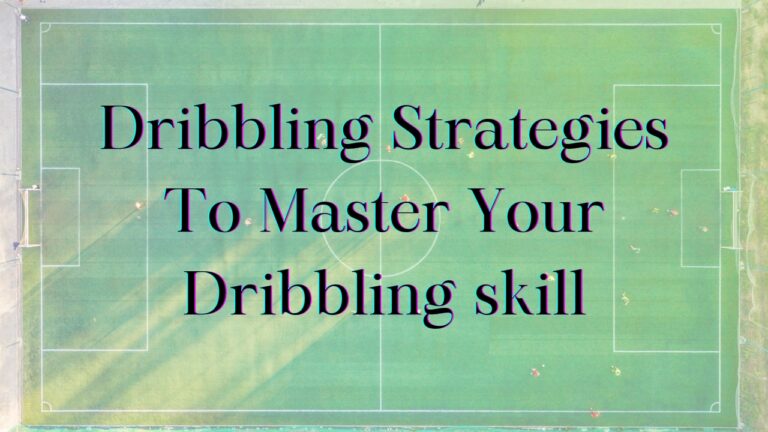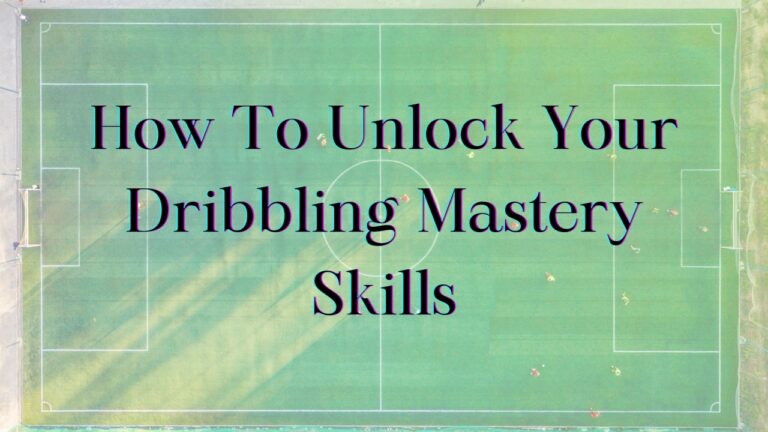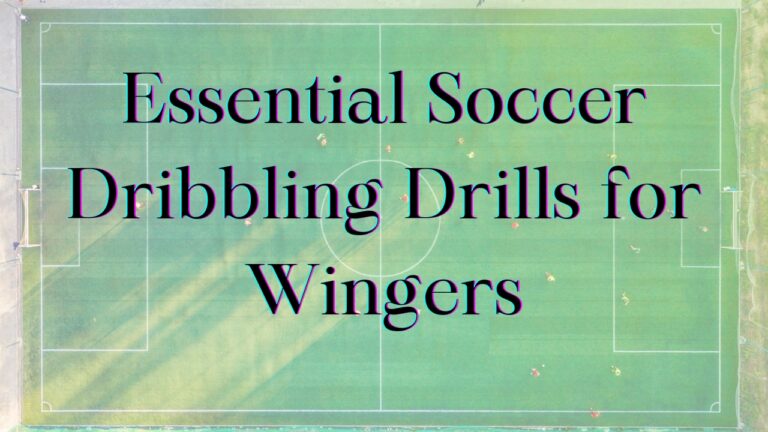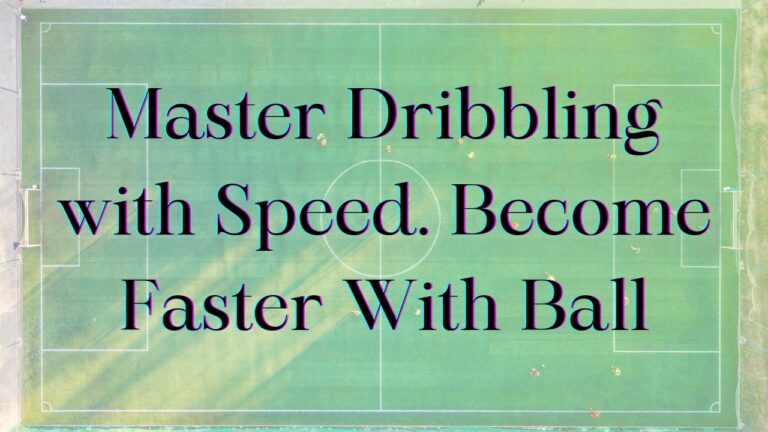Soccer dribbling is one of the most important skills for players to master. Having excellent ball control and dribbling technique is essential for beating defenders, creating scoring chances, and overall success on the field. Whether you’re just starting in soccer or looking to take your game to the next level, learning how to properly dribble a soccer ball is crucial.
Proper Stance and Body Positioning for Dribbling
The foundation of great dribbling starts with having the proper stance and body positioning. Here are the key points to focus on:
- Keep your knees bent: Maintain a slight bend in your knees that allows you to stay balanced and agile. Locked knees while dribbling will make it much harder to change direction.
- Lean slightly forward: Lean your body slightly forward to keep your center of gravity low. This helps you maintain control of the ball.
- Head up with eyes forward: Don’t look down at the ball. Keep your head up so you can see the field and look for open teammates. Use your peripheral vision to track the ball.
- Lower center of gravity: Bend your knees and lean forward to get your center of gravity lower to the ground. This balanced stance will help when quickly changing speed or direction.
By adopting the proper stance with knees bent, body leaning forward, head up, and center of gravity low, you’ll have the ideal foundation for dribbling a soccer ball.
Ball Control and Touch When Dribbling
Once you have the proper stance down, the next key to great dribbling is having excellent control and touch on the ball. Here are some tips:
- Use all surfaces of both feet: You don’t just dribble with your dominant foot. Use the inside, outside, laces, and sole of both feet to manipulate the ball in different directions. This makes you less predictable.
- Take soft, gentle touches: Don’t kick or force the ball. Keep the ball close with soft, short touches. This allows maximum control.
- Reduce force when changing direction: When you want to cut or change direction, don’t take a big touch. Soften your touch to keep the ball closer.
- Caress the ball: Think of “caressing” or “cuddling” the ball as you dribble rather than kicking it. This mindset will help you develop a gentle, subtle touch.
- Practice ball familiarity drills: Do ball familiarity drills like toe taps, inside/outside rolls, and moves like Maradonas to improve your overall touch.
Having soft, subtle touches using all parts of your feet will give you the ball control necessary to keep the ball close, change direction smoothly, and react quickly while dribbling.
Ideal Positioning of the Ball While Dribbling
Proper positioning of the ball relative to your body is another key element for an effective dribbling technique. Follow these guidelines:
- Keep the ball 1-2 feet away from your body: The ball should be close enough that you can easily reach out and touch it. Any further away and you lose some control.
- Ball on the outside of your dominant foot when moving forward: When dribbling forward, keep the ball on the outside of whichever foot is your stronger dribbling foot. This makes it easy to gently push the ball forward.
- Ball between your feet when changing direction: When you plan to cut or change direction, bring the ball between your feet so you can roll it off either foot. Don’t take big touches before changing direction.
- Shift ball from inside to the outside of feet: Using the inside and outside of your feet interchangeably while dribbling makes direction changes smoother.
- Reactive, not predictive positioning: Don’t just put the ball at a fixed distance/angle from you. Reactively position the ball based on the situation.
Keeping the ball close, on the outside of your dominant foot, and between your feet when changing direction will give you optimal ball control.
Dribbling Technique and Method
Once you have the proper stance, touch, and ball positioning down, it’s time to focus on the actual dribbling technique:
- Take small, measured touches: Don’t try to kick the ball too far forward. Small, subtle touches keep the ball under control.
- Accelerate and decelerate smoothly: Gradually speed up and slow down as you change pace. Don’t go from 0 to 100 instantly.
- Change speed and direction without losing control: Make cuts, turns, and stops fluidly while maintaining ball control through proper touch and positioning.
- Push the ball diagonally: When accelerating forward, push the ball somewhat diagonally rather than straight ahead. This makes it easier to beat defenders.
- Use different surfaces of feet: Vary touches using the inside, outside, laces, and sole of your feet for smoother changes of direction.
- Keep your head up: Don’t look at the ball. Scan the field to spot openings and approaching defenders.
The proper dribbling technique is all about control – controlling the pace, direction changes, and the ball itself through measured touches while maintaining field awareness.
Beating Defenders with Dribbling Skills
The fun part of dribbling is using your technique to beat defenders. Here are some tips for getting past opponents:
- Use feints and body movements: Fake a movement or footwork with your body to unbalance the defender before explosively changing direction.
- Explosively change pace or direction: Go slow to fast or cut left to right suddenly before the defender can react.
- Master skill moves like stepovers, Maradonas, etc.: Skills allow you to unbalance defenders and beat them with quick footwork.
- Combine sequences of moves: Do a stepover, followed by a Maradona roll, followed by an explosive diagonal run to lose defenders.
- Accelerate into open space: Spot gaps and seams to accelerate into with the ball once you beat the defender.
- Be unpredictable: Vary your moves and direction changes so defenders can’t anticipate what’s coming.
With practice, you’ll be able to utilize an arsenal of feints, skills, pace changes, and directional changes to beat defenders while dribbling. It just takes creativity and repetition!
Types of Dribbles in Soccer
There are several different types of dribbles soccer players use:
- Control Dribble: The ball stays very close to your feet, within 1 foot. Used to maintain close control in tight spaces.
- Speed Dribble: The ball is farther from your feet, up to 2-3 feet away. Used during fast attacking runs down the wings or on counterattacks.
- Change of Direction Dribble: Closer dribble using the inside/outside of feet to quickly cut in different directions to beat defenders.
- Attacking Dribble: More aggressive dribble directly at defenders, using skills and feints to unbalance them.
- Counterattacking Dribble: On counterattacks, dribble at speed into the open spaces left by the opponent pushing numbers forward.
- Wing Dribble: Dribbling down the touchline, keeping the ball close, and beating defenders to cross.
- 1v1 Dribble: Dribbling directly at one defender trying to beat them and create a scoring chance.
The type of dribble depends on the situation – beating defenders, maintaining control, attacking with speed, or countering into space.
Read More: 7 Keys to Unlock Dribbling Mastery for Youth Soccer Players
Advanced Dribbling Skills and Moves
Once you master the basics, it’s time to learn some advanced footwork and moves:
- Matthews: Tap the ball forward then quickly tap it between your feet and accelerate away.
- Maradona: Put the bottom of your foot on top of the ball, roll over the ball to the opposite foot, and accelerate away behind the defender.
- Scissors: Fake one direction, tap the ball to the opposite foot, and explode the other way.
- Stepovers: Fake in one direction by stepping over the ball and exit the other way.
- Reverse Stepover: Fake stepover by rolling your foot over the top of the ball before exiting the other way.
- Chops: Fake a pass before tapping the ball in a new direction with the outside of the dominant foot.
- Fakes and feints: Fake a touch, shot, or movement to unbalance the defender before explosively changing direction.
When first learning advanced moves, go slow and focus on proper technique. Gradually increase the speed with practice. Master individual moves before combining sequences of skills against defenders.
Applying Dribbling in Small-Sided Games
One of the best ways to improve your dribbling technique is by applying it in small-sided games:
- 1v1 games: Go against a single defender and work on your ball control and beating opponents with the dribble.
- 2v2 games: Incorporate passing but look to dribble at defenders when you receive the ball. Focus on footwork in tight spaces.
- 3v3 games: Passing, receiving, and beating multiple defenders. Opportunities to attack space if you beat the initial defender.
- 4v4 and 5v5 games: Require decision-making on when to pass vs dribble. More defenders to try and beat.
- Keep score: Adding competition and score-keeping to games adds incentive to take on defenders.
- Try rules requiring a minimum number of touches: Forces you to focus on close control rather than just kicking the ball away.
Small-sided games present live scenarios to practice your dribbling technique against real defenders applying pressure. The tighter spaces develop footwork and ball control.
Drills to Improve Dribbling Skills
In addition to small-sided games, dedicated drills can help refine your technique:
- Cone drills: Weave in and out of a line of cones, alternating touches with both feet.
- Ladder drills: Improve foot coordination by dribbling in and out of ladder rungs.
- Juggling: Keep the ball in the air with different parts of your feet to improve touch.
- Acceleration-deceleration: Practice explosively speeding up and slowing down while maintaining control.
- Ball taps: Alternate tapping the top, middle, and sole of the ball to stay on your toes.
- Toe taps: Lightly touch the ball side-to-side using just your toes to work on subtle touches.
- Outside cuts: Place the cone to your left, dribble around it using just the outside of your right foot, and vice versa.
Performing focused repetitive drills like these will help refine your dribbling technique. Do each drill for 10-15 minutes daily.
Watch the Best Dribblers for Inspiration
One final way to elevate your dribbling skills is by studying professional soccer players with fantastic technique:
- Lionel Messi: Considered by many the greatest dribbler ever. Close control, and incredible footwork.
- Neymar Jr.: Amazing flair and creativity. He can beat multiple defenders with his skills.
- Eden Hazard: Swift change of pace and direction. Unpredictable and slippery.
- Cristiano Ronaldo: Lightning-quick stepovers and close control at high speeds.
- Arjen Robben: Master of the inverted diagonal dribble inside from the wing.
- Andres Iniesta: Smooth feints and turns using all parts of feet to glide by defenders.
YouTube compilations of these players are a goldmine. Analyze their techniques in slow motion. Pause and rewind key moments. Look for small details you can incorporate into your dribbling. Imitate and replicate their moves and footwork patterns.
Conclusion
Dribbling a soccer ball like a pro requires mastering proper technique and skills through regular, focused practice.
Mastering how to dribble a soccer ball takes dedication, but with regular practice of proper technique and skills, you’ll be embarrassing defenders in no time!
Read More: Tactical Dribbling Strategies to Dominate on the Field
Author





